【转载】Python实现信号滤波(基于scipy)
Posted
tags:
篇首语:本文由小常识网(cha138.com)小编为大家整理,主要介绍了【转载】Python实现信号滤波(基于scipy)相关的知识,希望对你有一定的参考价值。
参考技术A 利用Python scipy.signal.filtfilt() 实现信号滤波https://blog.csdn.net/weixin_37996604/article/details/82864680
https://www.cnblogs.com/xiaosongshine/p/10831931.html
https://stackoverflow.com/questions/35565540/designing-an-fir-notch-filter-with-python
Required input defintions are as follows;
time: Time between samples
band: The bandwidth around the centerline freqency that you wish to filter
freq: The centerline frequency to be filtered
ripple: The maximum passband ripple that is allowed in db
order: The filter order. For FIR notch filters this is best set to 2 or 3, IIR filters are best suited for high values of order. This algorithm is hard coded to FIR filters
filter_type: 'butter', 'bessel', 'cheby1', 'cheby2', 'ellip'
data: the data to be filtered
用python设计FIR陷波滤波器
https://docs.scipy.org/doc/scipy/reference/generated/scipy.signal.iirnotch.html
https://www.cnpython.com/qa/85882
https://vimsky.com/examples/usage/python-scipy.signal.iirnotch.html
https://github.com/scipy/scipy/blob/master/scipy/signal/filter_design.py
https://blog.csdn.net/qq_41978536/article/details/90736793
Python图像处理使用低通滤波器模糊图像
使用低通滤波器模糊图像
0. 前言
低通滤波器 (Low Pass Filter, LPF) 过滤了图像中的高频部分,并仅允许低频部分通过。因此,在图像上应用 LPF 会删除图像中的细节/边缘和噪声/离群值,此过程也称为图像模糊(或平滑),图像平滑可以作为复杂图像处理任务的预处理部分。在本节中,我们将学习如何使用不同类型的滤波器核执行图像卷积以模糊图像。
1. 频域中的不同类型的核与卷积
1.1 图像模糊分类
图像模糊通常包含以下类型:
- 边缘模糊 (
Edge) 这种类型的模糊通常通过卷积显式地应用于图像,例如线性滤波器核或高斯核等,使用这些滤波器核可以平滑/去除图像中不必要的细节/噪声。 - 运动模糊 (
Motion) 通常是由于相机在拍摄图像时抖动所产生的,也就是说,摄像机或被拍摄的对象处于移动状态。我们可以使用点扩展函数来模拟这种模糊。 - 失焦模糊 (
de-focus) 当相机拍摄的对象失焦时,会产生这种类型的模糊;我们可以使用模糊 (blur) 核来模拟这种模糊。
接下来,我们创建以上三种不同类型的核,并将它们应用于图像以观察不同类型核处理图像后的结果。
1.2 使用不同核执行图像模糊
(1) 我们首先定义函数 get_gaussian_edge_blur_kernel() 以返回 2D 高斯模糊核用于边缘模糊。该函数接受高斯标准差 (
σ
σ
σ) 以及创建 2D 核的大小(例如,sz = 15 将创建尺寸为 15x15 的核)作为函数的参数。如下所示,首先创建了一个 1D 高斯核,然后计算两个 1D 高斯核的外积返回 2D 核:
import numpy as np
import numpy.fft as fp
from skimage.io import imread
from skimage.color import rgb2gray
import matplotlib.pyplot as plt
import cv2
def get_gaussian_edge_blur_kernel(sigma, sz=15):
# First create a 1-D Gaussian kernel
x = np.linspace(-10, 10, sz)
kernel_1d = np.exp(-x**2/sigma**2)
kernel_1d /= np.trapz(kernel_1d) # normalize the sum to 1.0
# create a 2-D Gaussian kernel from the 1-D kernel
kernel_2d = kernel_1d[:, np.newaxis] * kernel_1d[np.newaxis, :]
return kernel_2d
(2) 接下来,定义函数 get_motion_blur_kernel() 以生成运动模糊核,得到给定长度且特定方向(角度)的线作为卷积核,以模拟输入图像的运动模糊效果:
def get_motion_blur_kernel(ln, angle, sz=15):
kern = np.ones((1, ln), np.float32)
angle = -np.pi*angle/180
c, s = np.cos(angle), np.sin(angle)
A = np.float32([[c, -s, 0], [s, c, 0]])
sz2 = sz // 2
A[:,2] = (sz2, sz2) - np.dot(A[:,:2], ((ln-1)*0.5, 0))
kern = cv2.warpAffine(kern, A, (sz, sz), flags=cv2.INTER_CUBIC)
return kern
函数 get_motion_blur_kernel() 将模糊的长度和角度以及模糊核的尺寸作为参数,函数使用 OpenCV 的 warpaffine() 函数返回核矩阵(以矩阵中心为中点,使用给定长度和给定角度得到核)。
(3) 最后,定义函数 get_out_of_focus_kernel() 以生成失焦核(模拟图像失焦模糊),其根据给定半径创建圆用作卷积核,该函数接受半径 R (Deocus Radius) 和要生成的核大小作为输入参数:
def get_out_of_focus_kernel(r, sz=15):
kern = np.zeros((sz, sz), np.uint8)
cv2.circle(kern, (sz, sz), r, 255, -1, cv2.LINE_AA, shift=1)
kern = np.float32(kern) / 255
return kern
(4) 接下来,实现函数 dft_convolve(),该函数使用图像的逐元素乘法和频域中的卷积核执行频域卷积(基于卷积定理)。该函数还绘制输入图像、核和卷积计算后得到的输出图像:
def dft_convolve(im, kernel):
F_im = fp.fft2(im)
#F_kernel = fp.fft2(kernel, s=im.shape)
F_kernel = fp.fft2(fp.ifftshift(kernel), s=im.shape)
F_filtered = F_im * F_kernel
im_filtered = fp.ifft2(F_filtered)
cmap = 'RdBu'
plt.figure(figsize=(20,10))
plt.gray()
plt.subplot(131), plt.imshow(im), plt.axis('off'), plt.title('input image', size=10)
plt.subplot(132), plt.imshow(kernel, cmap=cmap), plt.title('kernel', size=10)
plt.subplot(133), plt.imshow(im_filtered.real), plt.axis('off'), plt.title('output image', size=10)
plt.tight_layout()
plt.show()
(5) 将 get_gaussian_edge_blur_kernel() 核函数应用于图像,并绘制输入,核和输出模糊图像:
im = rgb2gray(imread('3.png'))
kernel = get_gaussian_edge_blur_kernel(25, 25)
dft_convolve(im, kernel)
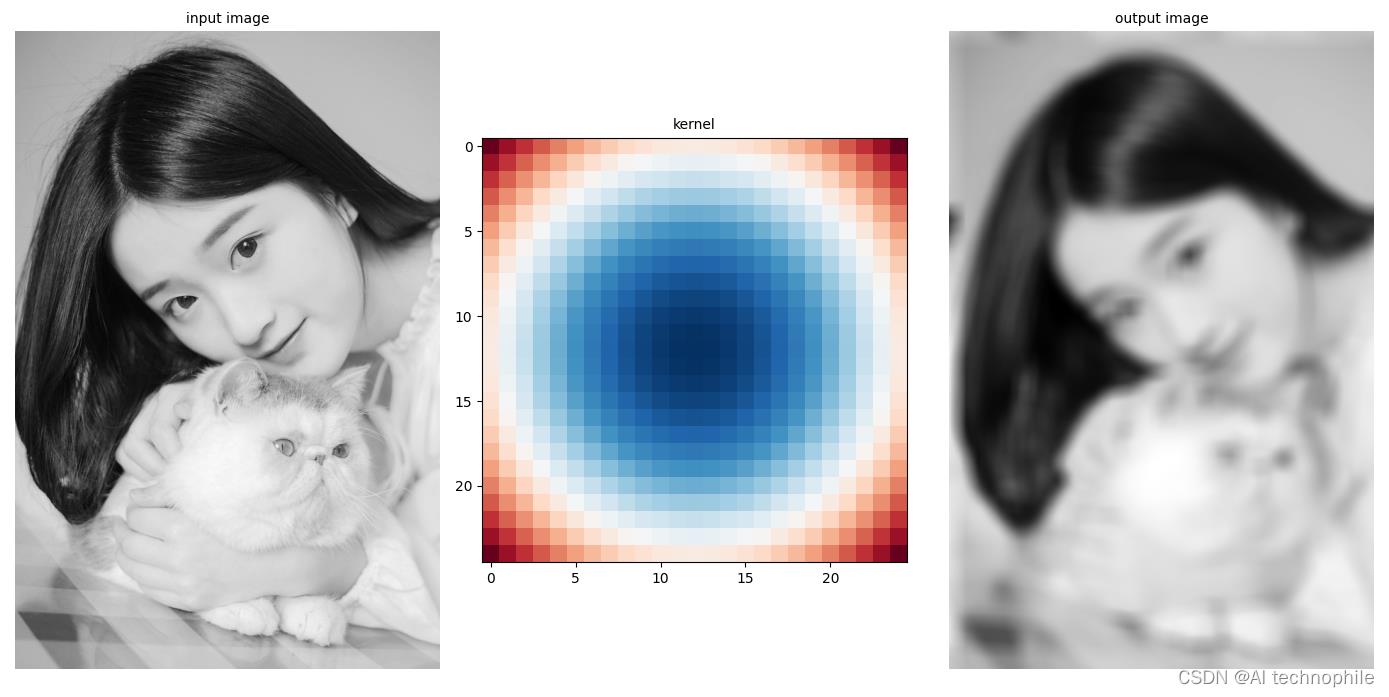
(6) 接下来,将 get_motion_blur_kernel() 函数应用于图像,并绘制输入,核和输出模糊图像:
kernel = get_motion_blur_kernel(30, 60, 25)
dft_convolve(im, kernel)
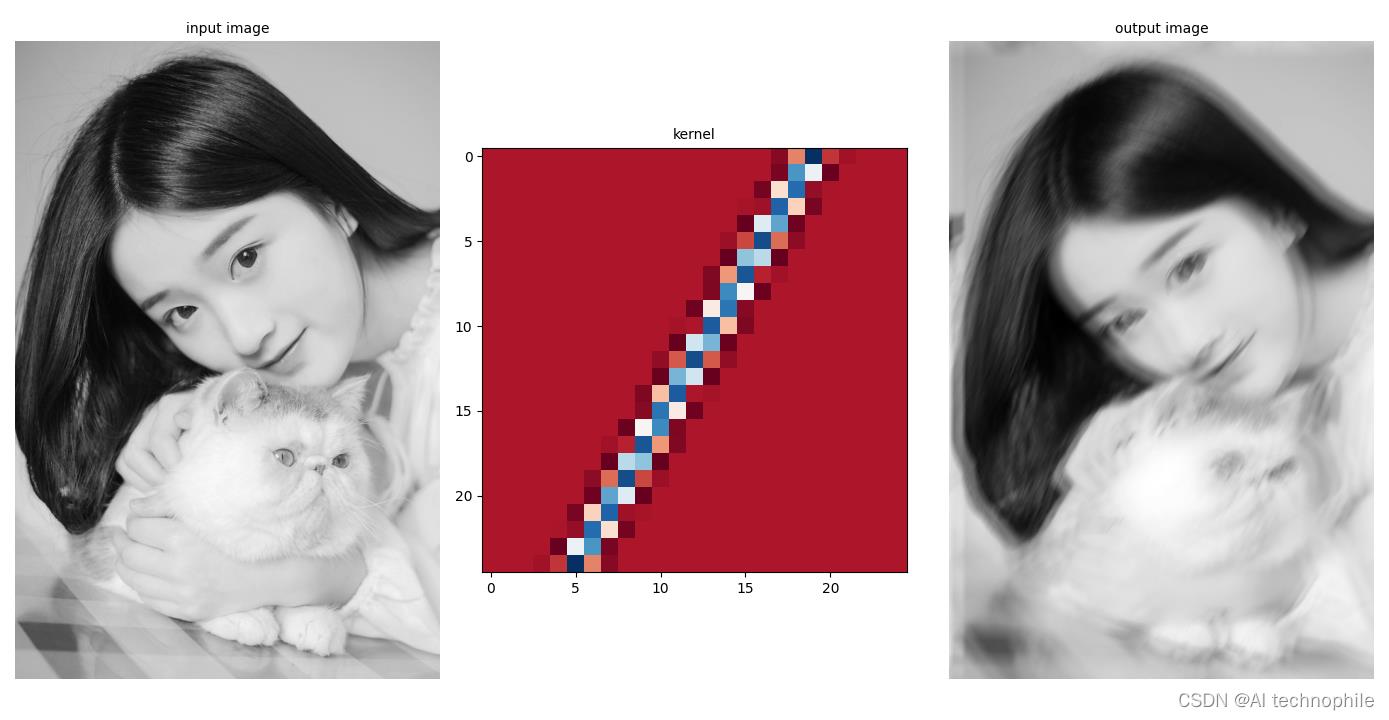
(7) 最后,将 get_out_of_focus_kernel() 函数应用于图像,并绘制输入,核和输出模糊图像:
kernel = get_out_of_focus_kernel(15, 20)
dft_convolve(im, kernel)

2. 使用 scipy.ndimage 滤波器模糊图像
scipy.ndimage 模块提供了一系列可以在频域中对图像应用低通滤波器的函数。本节中,我们通过几个示例学习其中一些滤波器的用法。
2.1 使用 fourier_gaussian() 函数
使用 scipy.ndimage 库中的 fourier_gaussian() 函数在频域中使用高斯核执行卷积操作。
(1) 首先,读取输入图像,并将其转换为灰度图像,并通过使用 FFT 获取其频域表示:
import numpy as np
import numpy.fft as fp
from skimage.io import imread
import matplotlib.pyplot as plt
from scipy import ndimage
im = imread('1.png', as_gray=True)
freq = fp.fft2(im)
(2) 接下来,使用 fourier_gaussian() 函数对图像执行模糊操作,使用两个具有不同标准差的高斯核,绘制输入、输出图像以及功率谱:
fig, axes = plt.subplots(2, 3, figsize=(20,15))
plt.subplots_adjust(0,0,1,0.95,0.05,0.05)
plt.gray() # show the filtered result in grayscale
axes[0, 0].imshow(im), axes[0, 0].set_title('Original Image', size=10)
axes[1, 0].imshow((20*np.log10( 0.1 + fp.fftshift(freq))).real.astype(int)), axes[1, 0].set_title('Original Image Spectrum', size=10)
i = 1
for sigma in [3,5]:
convolved_freq = ndimage.fourier_gaussian(freq, sigma=sigma)
convolved = fp.ifft2(convolved_freq).real # the imaginary part is an artifact
axes[0, i].imshow(convolved)
axes[0, i].set_title(r'Output with FFT Gaussian Blur, $\\sigma$='.format(sigma), size=10)
axes[1, i].imshow((20*np.log10( 0.1 + fp.fftshift(convolved_freq))).real.astype(int))
axes[1, i].set_title(r'Spectrum with FFT Gaussian Blur, $\\sigma$='.format(sigma), size=10)
i += 1
for a in axes.ravel():
a.axis('off')
plt.show()
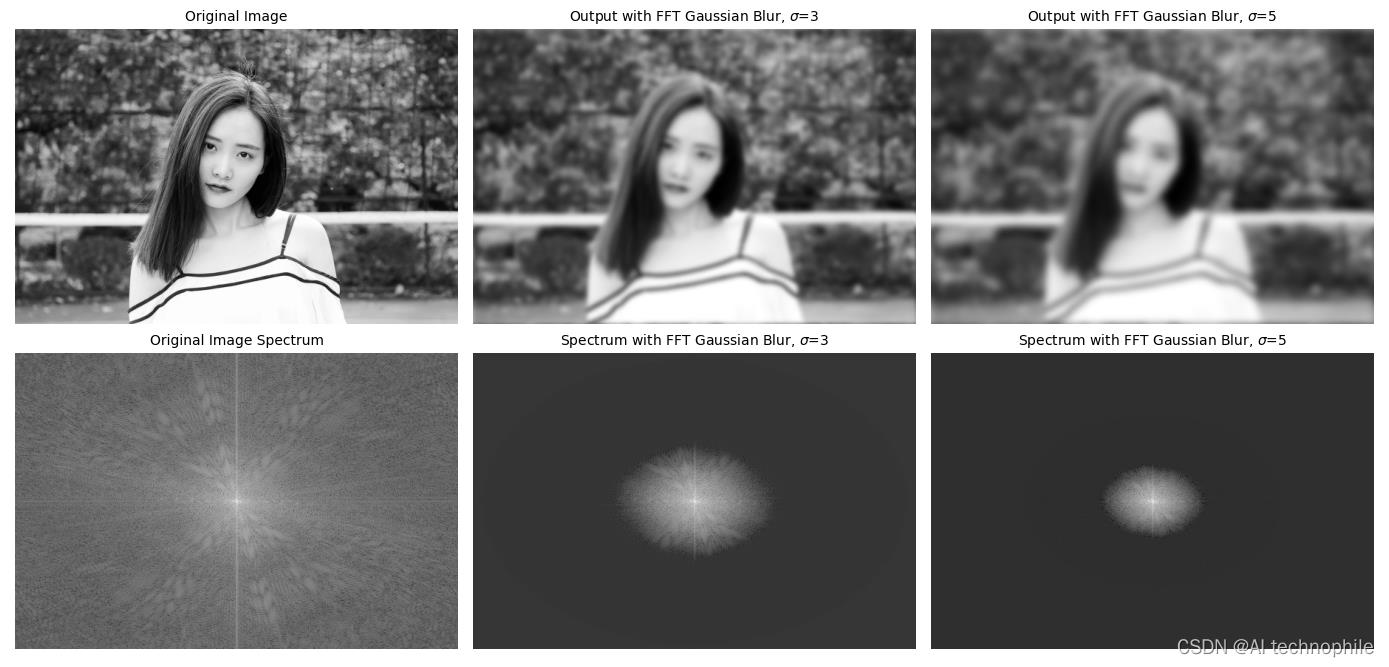
从上图中可以看出,高斯核的标准差
σ
σ
σ 值越大,输出图像就会越模糊。
2.2 使用 fourier_uniform() 函数
scipy.ndimage 模块的函数 fourier_uniform() 实现了多维均匀傅立叶滤波器。频率阵列与给定尺寸的方形核的傅立叶变换相乘。接下来,我们学习如何使用 LPF (均值滤波器)模糊输入灰度图像。
(1) 首先,读取输入图像并使用 DFT 获取其频域表示:
im = imread('1.png', as_gray=True)
freq = fp.fft2(im)
(2) 然后,使用函数 fourier_uniform() 应用 10x10 方形核(由功率谱上的参数指定),以获取平滑输出:
freq_uniform = ndimage.fourier_uniform(freq, size=10)
(3) 绘制原始输入图像和模糊后的图像:
fig, (axes1, axes2) = plt.subplots(1, 2, figsize=(20,10))
plt.gray() # show the result in grayscale
im1 = fp.ifft2(freq_uniform)
axes1.imshow(im), axes1.axis('off')
axes1.set_title('Original Image', size=10)
axes2.imshow(im1.real) # the imaginary part is an artifact
axes2.axis('off')
axes2.set_title('Blurred Image with Fourier Uniform', size=10)
plt.tight_layout()
plt.show()
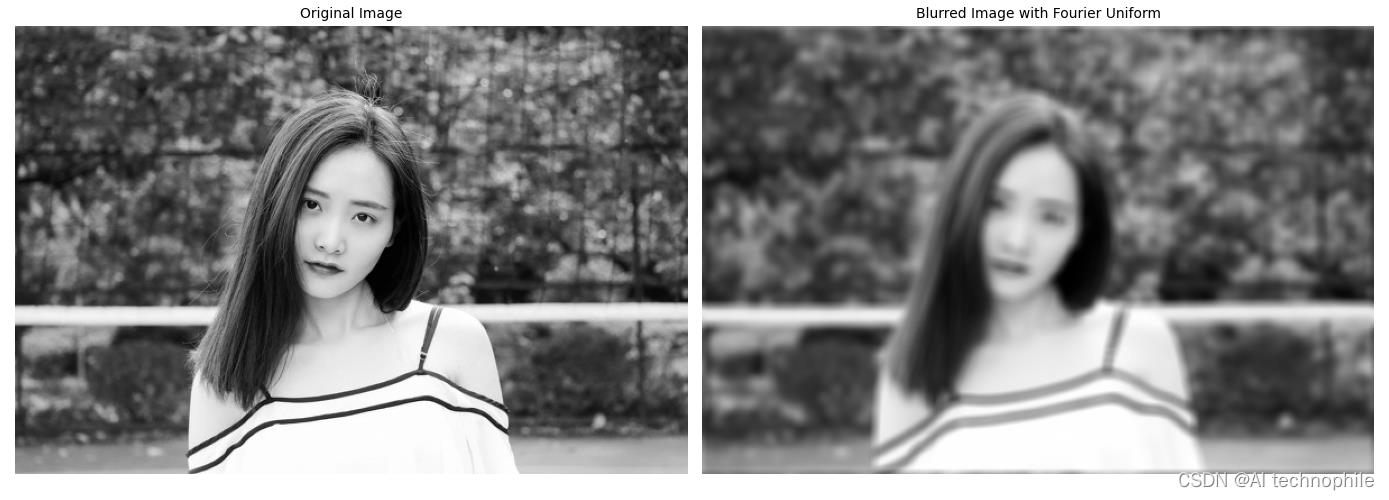
(4) 最后,绘制显示方形核的功率谱:
plt.figure(figsize=(10,10))
plt.imshow( (20*np.log10( 0.1 + fp.fftshift(freq_uniform))).real.astype(int))
plt.title('Frequency Spectrum with fourier uniform', size=10)
plt.show()

2.3 使用 fourier_ellipsoid() 函数
与上一小节类似,通过将方形核修改为椭圆形核,我们可以使用椭圆形核生成模糊的输出图像。
(1) 类似的,我们首先在图像的功率谱上应用函数 fourier_ellipsoid(),并使用 IDFT 在空间域中获得模糊后的输出图像:
freq_ellipsoid = ndimage.fourier_ellipsoid(freq, size=10)
im1 = fp.ifft2(freq_ellipsoid)
(2) 接下来,绘制原始输入图像和模糊后的图像:
fig, (axes1, axes2) = plt.subplots(1, 2, figsize=(20,10))
axes1.imshow(im), axes1.axis('off')
axes1.set_title('Original Image', size=10)
axes2.imshow(im1.real) # the imaginary part is an artifact
axes2.axis('off')
axes2.set_title('Blurred Image with Fourier Ellipsoid', size=10)
plt.tight_layout()
plt.show()

(3) 最后,显示应用椭圆形核后图像的频谱:
plt.figure(figsize=(10,10))
plt.imshow( (20*np.log10( 0.1 + fp.fftshift(freq_ellipsoid))).real.astype(int))
plt.title('Frequency Spectrum with Fourier ellipsoid', size=10)
plt.show()
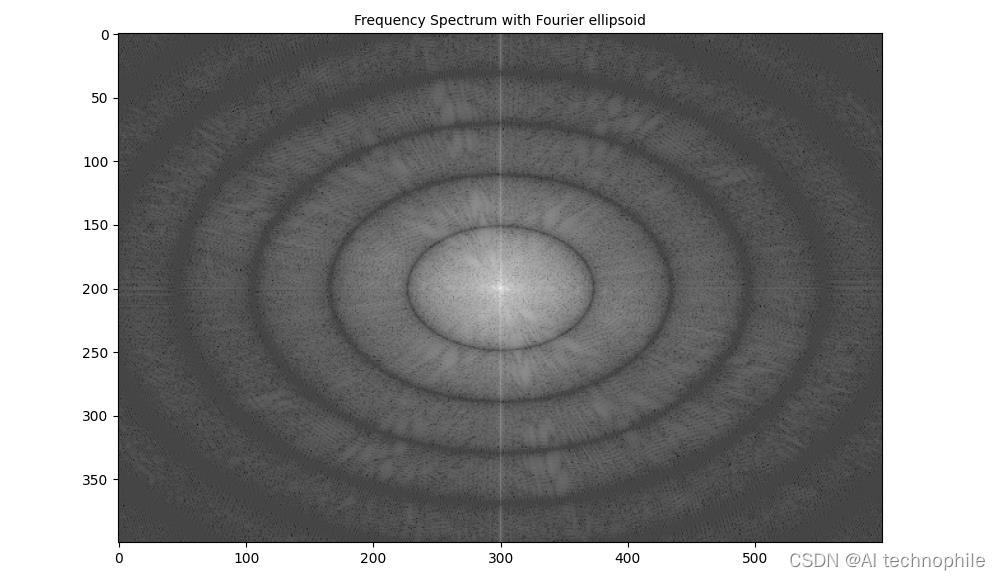
3. 使用 scipy.fftpack 实现高斯模糊
我们已经学习了如何在实际应用中使用 numpy.fft 模块的 2D-FFT。在本节中,我们将介绍 scipy.fftpack 模块的 fft2() 函数用于实现高斯模糊。
(1) 使用灰度图像作为输入,并使用 FFT 从图像中创建 2D 频率响应数组:
import numpy as np
import numpy.fft as fp
from skimage.color import rgb2gray
from skimage.io import imread
import matplotlib.pyplot as plt
from scipy import signal
from matplotlib.ticker import LinearLocator, FormatStrFormatter
im = rgb2gray(imread('1.png'))
freq = fp.fft2(im)
(2) 通过计算两个 1D 高斯核的外积,在空间域中创建高斯 2D 核用作 LPF:
kernel = np.outer(signal.gaussian(im.shape[0], 1), signal.gaussian(im.shape[1], 1))
(3) 使用 DFT 获得高斯核的频率响应:
freq_kernel = fp.fft2(fp.ifftshift(kernel))
(4) 使用卷积定理通过逐元素乘法在频域中将 LPF 与输入图像卷积:
convolved = freq*freq_kernel # by the Convolution theorem
(5) 使用 IFFT 获得输出图像,需要注意的是,要正确显示输出图像,需要缩放输出图像:
im_blur = fp.ifft2(convolved).real
im_blur = 255 * im_blur / np.max(im_blur)
(6) 绘制图像、高斯核和在频域中卷积后获得图像的功率谱,可以使用 matplotlib.colormap 绘制色,以了解不同坐标下的频率响应值:
plt.figure(figsize=(20,20))
plt.subplot(221), plt.imshow(kernel, cmap='coolwarm'), plt.colorbar()
plt.title('Gaussian Blur Kernel', size=10)
plt.subplot(222)
plt.imshow( (20*np.log10( 0.01 + fp.fftshift(freq_kernel))).real.astype(int), cmap='inferno')
plt.colorbar()
plt.title('Gaussian Blur Kernel (Freq. Spec.)', size=10)
plt.subplot(223), plt.imshow(im, cmap='gray'), plt.axis('off'), plt.title('Input Image', size=10)
plt.subplot(224), plt.imshow(im_blur, cmap='gray'), plt.axis('off'), plt.title('Output Blurred Image', size=10)
plt.tight_layout()
plt.show()

(7) 要绘制输入/输出图像和 3D 核的功率谱,我们定义函数 plot_3d(),使用 mpl_toolkits.mplot3d 模块的 plot_surface() 函数获取 3D 功率谱图,给定相应的 Y 和Z值作为 2D 阵列传递:
def plot_3d(X, Y, Z, cmap=plt.cm.seismic):
fig = plt.figure(figsize=(20,20))
ax = fig.gca(projection='3d')
# Plot the surface.
surf = ax.plot_surface(X, Y, Z, cmap=cmap, linewidth=5, antialiased=False)
#ax.plot_wireframe(X, Y, Z, rstride=10, cstride=10)
#ax.set_zscale("log", nonposx='clip')
#ax.zaxis.set_scale('log')
ax.zaxis.set_major_locator(LinearLocator(10))
ax.zaxis.set_major_formatter(FormatStrFormatter('%.02f'))
ax.set_xlabel('F1', size=15)
ax.set_ylabel('F2', size=15)
ax.set_zlabel('Freq Response', size=15)
#ax.set_zlim((-40,10))
# Add a color bar which maps values to colors.
fig.colorbar(surf) #, shrink=0.15, aspect=10)
#plt.title('Frequency Response of the Gaussian Kernel')
plt.show()
(8) 在 3D 空间中绘制高斯核的频率响应,并使用 plot_3d() 函数:
Y = np.arange(freq.shape[0]) #-freq.shape[0]//2,freq.shape[0]-freq.shape[0]//2)
X = np.arange(freq.shape[1]) #-freq.shape[1]//2,freq.shape[1]-freq.shape[1]//2)
X, Y = np.meshgrid(X, Y)
Z = (20*np.log10( 0.01 + fp.fftshift(freq_kernel))).real
plot_3d(X,Y,Z)
下图显示了 3D 空间中高斯 LPF 核的功率谱:

(9) 绘制 3D 空间中输入图像的功率谱:
Z = (20*np.log10( 0.01 + fp.fftshift(freq))).real
plot_3d(X,Y,Z)

(10) 最后,绘制输出图像的功率谱(通过将高斯核与输入图像卷积获得):
Z = (20*np.log10( 0.01 + fp.fftshift(convolved))).real
plot_3d(X,Y,Z)

从输出图像的频率响应中可以看出,高频组件被衰减,从而导致细节的平滑/丢失,并导致输出图像模糊。
4. 彩色图像频域卷积
在本节中,我们将学习使用 scipy.signal 模块的 fftconvolve() 函数,用于与 RGB 彩色输入图像进行频域卷积,从而生成 RGB 彩色模糊输出图像:
scipy.signal.fftconvolve(in1, in2, mode='full', axes=None)
函数使用 FFT 卷积两个 n 维数组 in1 和 in2,并由 mode 参数确定输出大小。卷积模式 mode 具有以下类型:
- 输出是输入的完全离散线性卷积,默认情况下使用此种卷积模式
- 输出仅由那些不依赖零填充的元素组成,
in1或in2的尺寸必须相同 - 输出的大小与
in1相同,并以输出为中心
4.1 基于 scipy.signal 模块的彩色图像频域卷积
接下来,我们实现高斯低通滤波器并使用 Laplacian 高通滤波器执行
以上是关于【转载】Python实现信号滤波(基于scipy)的主要内容,如果未能解决你的问题,请参考以下文章